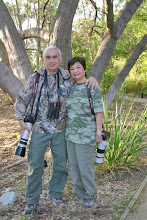I borrowed my son's Canon film camera with a 70-200 lens with the hope of getting some pictures of the birds in the area. I can tell that birds are a-plenty when we arrived as evidenced by a throng of bird-watchers seemingly all agog about a certain bird that was skulking among the needle-like leaves of the tamarisks. "American Redstart" was in the lips of every birder we met. Unfortunately, we never saw the object of their admiration. What we saw - and I was even able to get a photograph of - was a Chestnut-sided Warbler.

Little did I know that that bird was even rarer in Southern California than the "legendary" American Redstart. Of course, at that particular time and at that place, I was clueless as to what I was taking photographs of. One of the birders at the Tams was also holding a camera - a digital one. He noticed the antique device I was using and promptly began extolling the virtues of the "modern advances" in photography. Noticing the cynical look on my face, he then showed me the image of a warbler that he took no more than 5 minutes ago (and to think I would still have to wait a couple of days before I can see the results of my photographic endeavours). My jaw dropped a good 5 inches and my eyes leapt out of their sockets. The grinning man in front of me said something, of which only two words remained in my mind: Canoga Camera.
A week later Cynthia and I were at Canoga Camera buying a Canon Rebel 300D then the rage in digital SLRs. Thus began my long and oftentimes tedious adventure into birding and bird photography.
Now looking back after 6 years which involved newer camera models and telephoto lenses and several field guides, I'd like to think that my bird photographs are much better and my bird identification skills are much improved. And I am enjoying our birding trips immensely.
A Western Bluebird - one of my latest shots. Isn't it a tad better than the photo of the Chesnut-sided Warbler?









